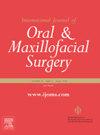上颌骨不对称患者正颌手术后咬肌和软组织变化的回顾性3D分析:12个月的CBCT研究
IF 2.7
3区 医学
Q2 DENTISTRY, ORAL SURGERY & MEDICINE
International journal of oral and maxillofacial surgery
Pub Date : 2025-04-14
DOI:10.1016/j.ijom.2025.04.002
引用次数: 0
摘要
本回顾性研究评估了20例严重不对称患者(7例女性,13例男性,16例女性)的咬肌(MM)和生殖器区软组织(GAST)的变化。年龄19-45岁),接受双颌正颌手术。术前和术后1年锥形束计算机断层扫描分析MM和GAST的变化。MM测量(线性、横断面和体积)在术前和术后期间,或在偏离侧(大脑偏离的一侧)和非偏离侧之间没有统计学上的显著差异。GAST测量结果显示,除了术前偏侧总软组织体积较高外,两侧间无显著差异(P = 0.028)。与术前和术后测量结果相比,术后偏差侧三个点的软组织厚度明显增加(Go5, P = 0.040;Go6, P = 0.023;Go7, P = 0.010)和一个在非偏差侧(Go3, P = 0.007)。术后无偏差侧皮肤体积明显增大(P = 0.044)。总之,软组织可能不能完全补偿潜在的骨骼不对称。MM和GAST表现出明显的形态学变化,强调在治疗计划中同时考虑硬组织和软组织因素的重要性。本文章由计算机程序翻译,如有差异,请以英文原文为准。
Retrospective 3D analysis of changes in the masseter muscles and soft tissues following orthognathic surgery for patients with maxillomandibular asymmetry: 12-month CBCT study
This retrospective study was performed to evaluate changes in the masseter muscles (MM) and gonial area soft tissues (GAST) in 20 patients with severe asymmetry (7 female, 13 male; age 19–45 years) who underwent bimaxillary orthognathic surgery. Preoperative and 1-year postoperative cone beam computed tomography scans were analysed for changes in the MM and GAST. No statistically significant difference in MM measurements (linear, cross-sectional, and volumetric) was observed between the preoperative and postoperative periods, or between the deviation side (side to which menton deviated) and non-deviation side. GAST measurements showed no significant difference between the sides, except for higher total soft tissue volume on the deviation side preoperatively (P = 0.028). Comparing the pre- and postoperative measurements, soft tissue thickness was significantly greater postoperatively at three points on the deviation side (Go5, P = 0.040; Go6, P = 0.023; Go7, P = 0.010) and one on the non-deviation side (Go3, P = 0.007). Skin volume was significantly greater postoperatively on the non-deviation side (P = 0.044). In conclusion, soft tissues may not fully compensate for underlying skeletal asymmetry. MM and GAST exhibit distinct morphological changes, underscoring the importance of considering both hard and soft tissue factors in treatment planning.
求助全文
通过发布文献求助,成功后即可免费获取论文全文。
去求助
来源期刊
CiteScore
5.10
自引率
4.20%
发文量
318
审稿时长
78 days
期刊介绍:
The International Journal of Oral & Maxillofacial Surgery is one of the leading journals in oral and maxillofacial surgery in the world. The Journal publishes papers of the highest scientific merit and widest possible scope on work in oral and maxillofacial surgery and supporting specialties.
The Journal is divided into sections, ensuring every aspect of oral and maxillofacial surgery is covered fully through a range of invited review articles, leading clinical and research articles, technical notes, abstracts, case reports and others. The sections include:
• Congenital and craniofacial deformities
• Orthognathic Surgery/Aesthetic facial surgery
• Trauma
• TMJ disorders
• Head and neck oncology
• Reconstructive surgery
• Implantology/Dentoalveolar surgery
• Clinical Pathology
• Oral Medicine
• Research and emerging technologies.

 求助内容:
求助内容: 应助结果提醒方式:
应助结果提醒方式:


